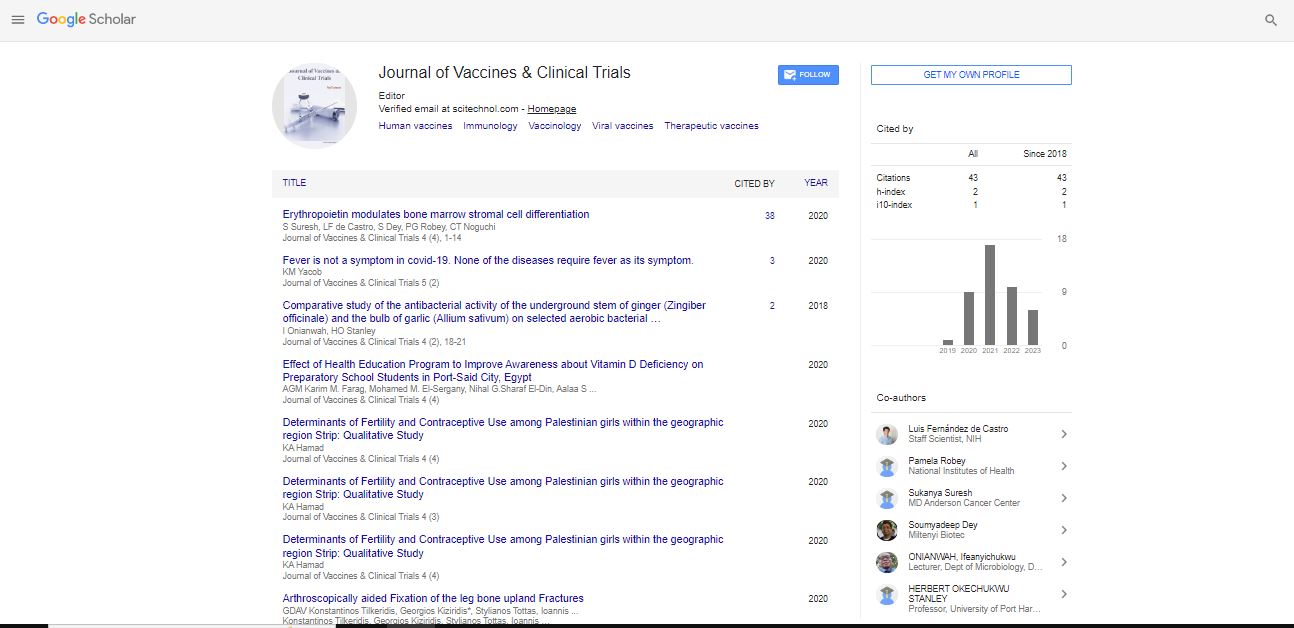Immunoglobulin Y production by yeast-immunized hens
Geraldo Balieiro Neto, Carlos Augusto Rosa, Jose Evandro de Moraes, Ana Raquel de Oliveira Santos, Fabio Enrique Lemos Budino, Jose Paulo Sampaio, Acyr Wanderley de Paula Freitas
FAPESP, Brazil
ICB/UFMG, Brazil
IZ/SAA, Brazil
FCT/UL, Portugal
: J Vacc Clin Trials
Abstract
IgY can be used for different biological functions, which are quite versatile and helpful to control microbiota in different ecosystems. Although egg yolk has been recognized as a convenient and inexpensive source of antibodies, vaccines and schedule immunizations change IgY concentrations in egg yolks, production, and economic efficiency. This work aimed to evaluate immunization schedules using spoilage yeasts during polyclonal antibody production to select the most efficient method. Spoilage yeast strains were thawed, grown in plates, collected by scratching, and aseptically transferred to a broth tube. The control vaccine (vaccine A: adjuvant plus PBS) was compared against three vaccines containing antigen strains known to consume lactic acid (vaccine B with 8.83 × 109 cells of Candida glabrata, Pichia kudriavzevii, and Pichia manshurica), sugar (vaccine C with 6.86 × 109 cells of Saccharomyces cerevisiae, Torulospora delbrueckii, and Schizosaccharomyces pombe), and mixed cultures combining B and C. One mL of each vaccine was deeply inoculated at 14, 28, or 42 interval days in the pectoral muscles of 252 hens. The experimental design was randomized plots in the 4 × 3 factorial arrangement. There was a significant interaction between vaccines and schedule immunizations. The treatments A, B, C, and D injected each at 14, 28, and 42 interval days presented as 22.62, 21.15, and 23.29; 58.89, 125.08, and 87.43; 149.06, 109.80, and 81.79; 192.20, 114.43, and 79.70 mg/yolk of IgY, respectively. The antimicrobial activity against yeasts prevented spoilage and ensured quality of the sugarcane silage. The IgY production procedure is simple and allows utilization of the remaining egg yolk as a food product. An added advantage is the elimination IgY purification steps, which can improve economic efficiency of IgY production. In conclusion, vaccine D injection at 14 days produced large-scale, high-yield active IgY and should be selected as the preferred method.
Biography
Geraldo Balieiro Neto with a Bachelor’s degree in Animal Science in 1992, Master’s degree in Animal Nutrition at USP/SP in 1998, and PhD in animal/livestock husbandry and production in 2007 at the Universidade Estadual Paulista Júlio de Mesquita Filho-UNESP/SP. In 2010, he completed a post-doctoral fellowship in Biotechnology at Evora University, Portugal. Since 1998, he has worked as a scientific researcher at São Paulo Government Department (APTA-SAA, 2005). He previously served as Director of research, member of the Biosafety Technique Committee of São Paulo Research Institute, and is the manager responsible for experimental herds at the Department of Agriculture and Food Supply of São Paulo Agency for Agribusiness Technology (SAA/APTA). Currently, he works in food safety and sustainable food production, and he has recently developed products as antibiotic alternatives.
E-mail: geraldobalieiro@iz.sp.gov.br
 Spanish
Spanish  Chinese
Chinese  Russian
Russian  German
German  French
French  Japanese
Japanese  Portuguese
Portuguese  Hindi
Hindi 